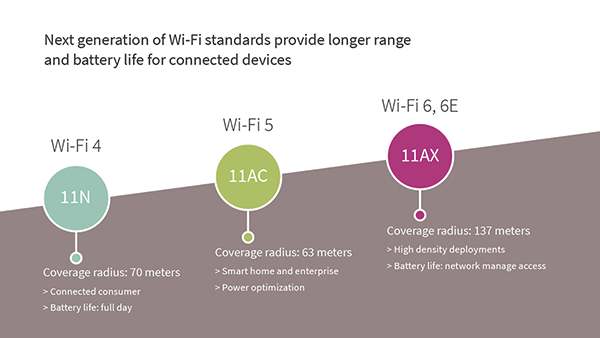
Wi-Fi 6E ushers in the next 20 years of Wi-Fi, stated the Wi-Fi Alliance in its announcement of the availability of its Wi-Fi 6E certification programme in January 2021. With the acquisition of Cypress Semiconductor in 2020, which had previously acquired Broadcom’s Internet of Things (IoT) business in 2016, Infineon Technologies has had a critical role in developing and implementing Wi-Fi since its very beginning. Providing nearly two decades of Wi-Fi leadership, Infineon has delivered technical guidance in the development and advancement of industry standards and continues to provide product leadership having shipped over three billion IoT chips.
The key criteria are driven by product and user experience drivers, including:
• Reliability. Wi-Fi 6E promises to reduce RF interference in the home through the opening of the 6 GHz band.
• Range/congestion. The Wi-Fi 6 standard has a number of features that address range and congestion issues that are important for IoT products.
• Adoption of Wi-Fi 6 routers. Many of the Wi-Fi 6 features impact customers when they are using Wi-Fi 6 routers.
• Cost. Cost is an important consideration in the selection of a Wi-Fi standard. There are multiple dimensions to consider here, including the cost of the chip, solution, integrations and more.
• Security. The Wi-Fi standards continue to evolve to improve security, including the introduction of WPA3, which is required for all Wi-Fi 6 products.
• Power consumption. For many battery-operated or power-sensitive IoT products, Wi-Fi 6 can provide a breakthrough in performance.
What Wi-Fi technologies are supported in the average home? How will they be changing in the near future?
It is not unusual to find routers that are 10 years old in use today. That means IEEE 802.11 a/b/g/n routers, even though the latest standard is IEEE 802.11 ax, which is called Wi-Fi 6. If targeted customers are not using a router with the latest technology (note: most Wi-Fi chips provide backwards compatibility), they will not be able to take advantage of the latest capabilities of those Wi-Fi chips. Fortunately, the infrastructure and adoption rate of Wi-Fi 6 and 6E is increasing.
For those customers who have access to Wi-Fi 6 and 6E, there are substantial performance benefits that they can enjoy. As Wi-Fi has become more important for IoT devices and as customers have more and more IoT devices in their homes, there are real and increasing challenges with congestion. Being aware of these challenges, the Wi-Fi Alliance has been working to solve them for years. With help from Infineon and other semiconductor companies, the Alliance developed the Wi-Fi 6 standard.
Wi-Fi 6 delivers several new capabilities that will enhance product performance, reliability, or quality of service (QoS) enabling more connected products in the home, and reduced power consumption for improved battery life in battery-operated products. These key performance indicators (KPIs) are important considerations for products that require high reliability, long range, and low power consumption. Clear, uncongested spectrum available in the 6 GHz band is critical for Wi-Fi 6E for IoT products to take advantage of for higher reliability and lower power consumption connections.

With the newly available standards and differences between legacy applications and the most advanced solutions, product managers need to consider technology products that provide them with flexibility and allow them to continually develop Wi-Fi products from Wi-Fi 4 to 5 to 6 and even 6E without totally redesigning in-between product iterations as their product families evolve. For Wi-Fi, portability from one generation to the next is essential. Wi-Fi 4 was not the end. Wi-Fi 5 was not the end and Wi-Fi 6 will not be the end either. Wi-Fi products designed today need to consider that the Wi-Fi offered in the future will provide software portability and consistent interfaces with those products as Wi-Fi continues to evolve from 5 to 6 and beyond. With increasing threats from bad actors, security is an essential upgrade in Wi-Fi 6E. Infineon has taken this security to an even higher level.
Wi-Fi 6 delivers a 50% reduction in standby power compared to any previous generation. For most use cases in the home, car or factory, this means a substantial increase in battery life. In addition, with Wi-Fi 6, integration of other network-related technologies is possible, for example, a solution combining Wi-Fi 6, and Bluetooth 5.2. There are few companies in the world that can develop such solutions and deliver a best-in-class user experience for coexistence, and Infineon is a member of this elite group. This means that Infineon can design and provide uniquely differentiated products incorporating Wi-Fi, and reduce cost pressure in a system design.
Choosing a partner who can offer the best choice in a variety of options and the best choice in each category is equally important. Based on the decades of involvement and billions of devices shipped, Infineon Wi-Fi solutions are fully compliant, so users can rely on Wi-Fi 6E certified solutions to confidently deliver the performance they require. As a trusted partner for eight of the 10 top IoT companies, investment in collateral to simplify design in and reduce time to market are an essential part of Infineon’s system approach to a solution based on complex and highly integrated ICs.
Moving from Wi-Fi, 4 to Wi-Fi 5 to Wi-Fi 6 and now Wi-Fi 6E, performance improves the user experience with improved latency, battery life, range, and throughput (speed). These improvements and user desire for them should provide substantial motivation for product managers to implement Wi-Fi 6E in new products. With its strong experience in Wi-Fi improvements from the very beginning, Infineon is paving the way for the ultimate Wi-Fi user experience with the performance users expect and the security they deserve.
| Tel: | +27 11 923 9600 |
| Email: | [email protected] |
| www: | www.altronarrow.com |
| Articles: | More information and articles about Altron Arrow |

© Technews Publishing (Pty) Ltd | All Rights Reserved